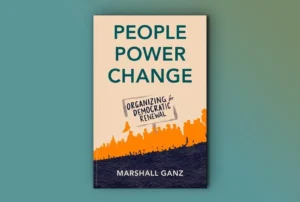
If one of the goals of philanthropy is to help solve intractable social problems, is it worth spending time on governance when so many urgent challenges demand action? A recent book on global board practices contends that the answer is a resounding “yes.” Attending to governance is essential, because approaching governance uncritically can perpetuate, rather than remedy, systemic inequality.
In her 2018 edited volume, Global Best Practices for CSO, NGO, and other Nonprofit Boards: Lessons from around the World, Penelope Cagney describes global governance practices and associated trends among nonprofits, often also called nongovernment organizations (NGOs) or civil society organizations (CSOs). Here, following the lead of the United Nations Development Program, I’ll use CSO since it’s the broadest and most inclusive term. Contributions from 20 international experts contextualize CSO governance practices through the lens of political, historical, socio-economic, and legal operating environments, painting a very clear picture as to why organizations approach governance so differently.
The book’s most important contribution, however, is its clear demonstration of the strong relationship between governance and culture. By understanding culture, organizations can become more effective and make much greater progress on solving complex social problems.
What Is Culture?
Drawing from a research framework developed in the 1990s in Riding the Waves of Culture: Understanding Diversity in Global Business by Fons Trompenaars and Charles Hampden-Turner, Cagney defines culture as the way people solve problems (page 4). That research examined 50,000 cases from 100 countries over a 15-year period, finding that there is no single “best” approach to problem solving. Rather, effective solutions depend largely on context.
The analysis identified seven dimensions of culture that influence the ways people and societies can approach solving problems. These include:
- universalism particularism (making judgments based on unchanging standards, vs. adapting principles based on context and relationships);
- individualism communitarianism, e.g., viewing each person as more important than the collective group’s welfare, and vice versa;
- neutral (showing emotional restraint) vs. affective (open expression of emotion);
- specific (keeping one’s public and private lives separate) vs. diffuse (commingling one’s public and private lives);
- ascription (gaining status by rank or social position) vs. achievement (gaining status through performance);
- synchronic (seeing past, present, and future as interwoven) vs. sequential (linear progression of time); and
- internal control (accepting circumstances in ways that enable you to transcend them), vs. external control (seeking to change and dominate one’s circumstances).
While these seven dimensions shed light on the construct of culture, they cannot be understood in isolation. They must be considered in relation to the context in which they are embedded.
Factors Affecting Culture
Relevant factors that influence governance practices include an organization’s size and age, its subsector (e.g., arts and culture, healthcare), the region’s prevailing norms of transparency and accountability, the degree of autonomy granted by the government, and how long the notion of civil society has existed there. Other moderating factors include the level of board member diversity and the emergence of social enterprise and hybrid organizations. These environmental factors, in tandem with the seven dimensions of culture, illuminate why there is no such thing as one-size-fits-all “best practices” in governance.
Global Manifestations of Governance
To bring this analytical framework to life, the book presents an overview of regional governance practices, beginning with Africa. The origin of CSOs there is traced from the colonial era to present day, providing historical insights into the multiple challenges of nonprofit governance. These include that some boards fail to observe term limits or maintain separate management and governance roles. These practices can be exacerbated by a lack of resources for board development and capacity building. Initiatives like the Fanikisha Institutional Strengthening Project and the Independent Code of Governance for Non-Profit Organisations in South Africa reflect efforts to create more transparent and accountable governance practices.
In Asia, CSOs generally experience stricter government monitoring compared to elsewhere in the world. Businesses in the region also increasingly embrace corporate social responsibility. However, practices and contexts vary widely by country. The book devotes sections to Cambodia, China, India, Indonesia, Japan, Korea, Philippines, and Singapore, describing their contextual differences and providing insights helpful to readers unfamiliar with governance practices in non-Western contexts. The section on China, for example, discusses that nation’s 2016 enactment of the Charity Law that regulates nonprofit and philanthropic activities there. This law requires financial and program reporting and prescribes what an organization must do to be eligible to raise funds online. The rise of social entrepreneurship in China has contributed to the birth of capacity-building organizations, such as the Non-Profit Incubator that provides training, networking, and developmental support for grassroots NGOs and social enterprises.
Sign up for our free newsletters
Subscribe to NPQ's newsletters to have our top stories delivered directly to your inbox.
By signing up, you agree to our privacy policy and terms of use, and to receive messages from NPQ and our partners.
Other regions featured include Australia and New Zealand (chapter 4), Central and Eastern Europe and Eurasia (5), Europe (6), Latin America (7), Middle East and North Africa (8), and North America (9). Examples from Aotearoa—the Maori name for New Zealand—offer insightful practices for developing culturally appropriate governance. One example is the “two house” model, where both non-Maori and Maori groups can meet using their respective customs and protocols. Another is the use of governance frameworks rooted in Maori principles, such as Hinengaro (remembering and learning from the past, knowing, dreaming, and listening to the wisdom of elders) to ensure self-determination and accountability in the context of relationships and their power dynamics.
Chapter 10 reviews the special challenges of governing large international CSOs (ICSOs), such as Oxfam, Save the Children, Greenpeace, and Transparency International. A 2017 survey of 26 ICSOs found that 85 percent use a federated model of governance, in part to ensure the independence of their national affiliates and to mirror the global governance models used by international institutions. A downside of the federated model is slowness—ICSO deliberations can be protracted and avoid topics and decisions likely to produce conflict. Also, ICSOs are dependent on their national members for financial support. This makes them susceptible to the golden rule of economics—those who have the gold make the rules. Thus, the international bodies often function more as coordinators than as leaders because they have little formal authority over the national members.
A central challenge of ICSOs is how to balance uneven power dynamics. Besides the issues mentioned above, ICSOs expressed the importance of preventing wealth from the Global North from overshadowing the knowledge and needs of the Global South, yet only 56 percent of survey respondents said they would like their ICSO’s governance to include more beneficiaries. Other pathologies not mentioned in the book include pay disparities between local and international aid workers; promotion of market solutions (e.g., loans, microfinance) that may perpetuate inequitable economic practices; hubris and lack of inclusion; and potential erosion of self-determination by ICSOs that claim legitimacy as promoters of global civil society without corresponding democratic representation.
The book makes several strategic recommendations to improve this power balancing, such as shifting from hierarchical structures of governance and management to networked platform structures, which, it is hoped, would help balance power among national, international, and local levels to put resources where they are most needed to ensure mission fulfillment. Beyond restructuring, rebalancing power will require humility and a servant-leadership mindset rather than conventional command-and-control approaches. Because stakeholders at the local level most often have the best understanding of needs and opportunities, they must be given decision-making authority for these organizations to be effective. Further, the organizations must ensure that diversity is reflected throughout the organization.
The Future of Governance
Like a Dickens novel, the final chapter presents a gloomy vision of what could transpire if powerful people and organizations unilaterally set the agenda, inequality continues to grow unchecked, and economic slowdowns and climate disasters shift focus from global well-being to nationalism. To prevent this, Cagney outlines a few steps that can be taken. For example, technology potentially can potentially be used to promote greater grassroots engagement and increase civil society participation.
She acknowledges, however, that technology alone will be insufficient. New mental models of governance, which are—effectively speaking, new social technologies—that is, ways of relating and making decisions in the world—are also needed to lead effectively in increasingly complex environments. Emerging practices that show great promise include distributed governance (see the work, for instance, of Judy Freiwirth) and generative governance (as outlined in Richard Chait, William Ryan, and Barbara Taylor’s Governance as Leadership). In these formulations, power is shared, and board members co-create solutions with stakeholders rather than patronizing or controlling them.
Besides coming away with a richer conceptualization of governance and culture, the thoughtful reader is left with the recognition that the governance challenges nonprofit organizations face mirror at a smaller scale the very problems they were formed to solve. How can our institutions and societies reconcile competing values, align action, and transform conflict into cooperation? To explore these ideas further, possible pathways include:
- Indigenous governance: The Maori governance scholars Penehira, Cram, and Pipi note, “It might be speculated that the new horizons for ‘western’ models of good governance lie in Indigenous knowledge and practice.” Indigenous approaches to governance are rooted in the right to self-determination, mutual respect, and a dynamic, relational orientation to nature, our past, our highest aspirations, and each other. Inclusivity and co-creation are key. As one participant in a First Nations workshop asked, “Are we just driving the bus somewhere, or is it about getting everyone on the bus in the parking lot and then deciding together where to go?” (Transitional Governance Project, 2017, p. 16).
- Networked governance: Nonprofit organizations are increasingly expected to collaborate to produce systemic change and social transformation. This collective approach requires that independent, autonomous organizations come together to coordinate their actions under ever-changing conditions. As David Renz wrote in the spring 2018 issue of NPQ, effective networked governance is characterized by inclusivity, adaptability, and clarity. Patti Anklam, the author of Net Work: A Practical guide to creating and sustaining networks at work and in the world, describes governance not as an end state, but as “an expression of increasing levels of coherence. The more conscious a network is of its need for governance, the deeper the conversations will be about how to achieve coherence” (p. 59). Thus, effective governance also entails organizations developing capacity for self-awareness. This enables them to become aware of the intangible and structural aspects of their own work so they can reshape it in ways the better serve the world.
- Self-Organizing governance: Elinor Ostrom won the 2009 Nobel Prize in economics for her research on how people come together to effectively govern shared resources like pastures and aquifers. By studying hundreds of cases around the world, she identified eight design principles for effective governance. These are: (1) strong group identity and sense of purpose; (2) participatory decision making; (3) fair distribution of costs and benefits; (4) monitoring of agreed behaviors; (5) graduated sanctions for misbehavior; (6) authority to self-govern; (7) resolving conflicts fairly, quickly, and transparently; and (8) establishing relationships with other relevant groups. Nonprofit boards would be wise to study these time-tested governance practices to develop adaptability, maintain harmonious relations, and effectively balance individual and collective interests.
Together, these models offer fruitful paths for exploring and improving the process and practice of governance. As nonprofit boards grapple with these issues in their own organizations, what they learn could help inform collective models for solving our most difficult social problems. Rather than staying stuck by arguing what practices are “best,” global governance teaches us that we can open up new pathways for effective action by expanding our problem-solving perspectives, aligning our decision making to sync with our operating environment, and balancing power dynamics by embracing equity and inclusion.












